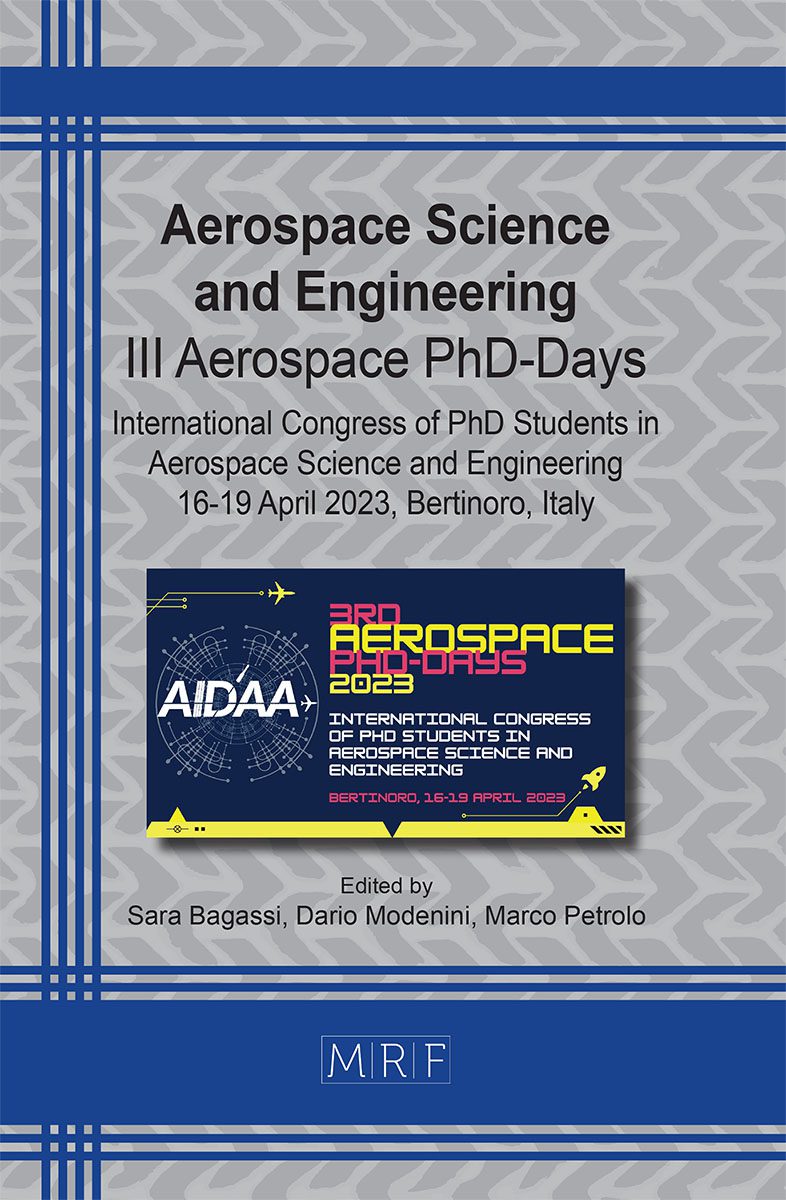Interplanetary trajectory design in high-fidelity model: Application to deep-space CubeSats’ cruises
Claudio Toquinho Campana
download PDFAbstract. This paper tackles the problem of first guess trajectory generation for interplanetary missions flying in chaotic environments. Simplified dynamical models are first exploited to perform the preliminary design of deep-space trajectories which leverage orbital perturbations. A real trajectory is then obtained by a refinement procedure in a high-fidelity model. A description of tools and methodologies which will be developed during this PhD research is provided.
Keywords
Highly Nonlinear Astrodynamics, Phase Space Analysis, Autonomous Interplanetary Cubesats, High-Fidelity Trajectory Design
Published online 9/1/2023, 8 pages
Copyright © 2023 by the author(s)
Published under license by Materials Research Forum LLC., Millersville PA, USA
Citation: Claudio Toquinho Campana, Interplanetary trajectory design in high-fidelity model: Application to deep-space CubeSats’ cruises, Materials Research Proceedings, Vol. 33, pp 185-192, 2023
DOI: https://doi.org/10.21741/9781644902677-27
The article was published as article 27 of the book Aerospace Science and Engineering
![]() Content from this work may be used under the terms of the Creative Commons Attribution 3.0 license. Any further distribution of this work must maintain attribution to the author(s) and the title of the work, journal citation and DOI.
Content from this work may be used under the terms of the Creative Commons Attribution 3.0 license. Any further distribution of this work must maintain attribution to the author(s) and the title of the work, journal citation and DOI.
References
[1] H. C. Alewine, «Space accounting,» Accounting, Auditing & Accountability Journal, vol. 33, p. 991-1018, 2020.https://doi.org/10.1108/AAAJ-06-2019-4040
[2] E. Kulu, «In-Space Economy in 2021 – Statistical overview and classification of commercial entities,» in 72nd International Astronautical Congress (IAC 2021), Dubai, United Arab Emirates, 2021.
[3] G. Di Domenico, E. Andreis, A. C. Morelli, G. Merisio, V. Franzese, C. Giordano, A. Morselli, P. Panicucci, F. Ferrari e F. Topputo, «Toward self-driving interplanetary CubeSats: the ERC-funded project EXTREMA,» in International Astronautical Congress: IAC proceedings, 2021.
[4] R. Walker, D. Koschny, C. Bramanti e I. Carnelli, «Miniaturised Asteroid Remote Geophysical Observer (M-ARGO): a stand-alone deep space CubeSat system for low-cost science and exploration missions,» in 6th Interplanetary CubeSat Workshop, Cambridge, UK, 2017.
[5] D. A. Dei Tos, «Trajectory optimization of limited control authority spacecraft in high-fidelity models,» 2018.
[6] F. Bernelli-Zazzera, F. Topputo e M. Massari, «Assessment of mission design including utilization of libration points and Weak Stability Boundaries,» 2004.
[7] W. S. Koon, M. W. Lo, J. E. Marsden e S. D. Ross, Dynamical systems, the three-body problem and space mission design, Marsden Books, 2011.
[8] E. J. Doedel, V. A. Romanov, R. C. Paffenroth, H. B. Keller, D. J. Dichmann, J. Galán-Vioque e A. Vanderbauwhede, «Elemental periodic orbits associated with the libration points in the circular restricted 3-body problem,» International Journal of Bifurcation and Chaos, vol. 17, p. 2625-2677, August 2007.https://doi.org/10.1142/S0218127407018671
[9] F. Topputo, M. Vasile e F. Bernelli-Zazzera, «Low energy interplanetary transfers exploiting invariant manifolds of the restricted three-body problem,» The Journal of the Astronautical Sciences, vol. 53, p. 353-372, December 2005.https://doi.org/10.1007/BF03546358
[10] F. Topputo, «On optimal two-impulse Earth-Moon transfers in a four-body model,» Celestial Mechanics and Dynamical Astronomy, vol. 117, p. 279-313, August 2013.https://doi.org/10.1007/s10569-013-9513-8
[11] D. A. Dei Tos, «Automated trajectory refinement of three body orbits in the real solar system model. Dynamical substitutes of Lagrangian points and quasi-periodic orbits about them,» 2014.
[12] K. Oshima, F. Topputo e T. Yanao, «Low-energy transfers to the Moon with long transfer time,» Celestial Mechanics and Dynamical Astronomy, vol. 131, January 2019.https://doi.org/10.1007/s10569-019-9883-7
[13] D. A. Dei Tos e F. Topputo, «On the advantages of exploiting the hierarchical structure of astrodynamical models,» Acta Astronautica, vol. 136, p. 236-247, July 2017.https://doi.org/10.1016/j.actaastro.2017.02.025
[14] V. G. Szebehely, Theory of orbit: the restricted problem of three bodies, Academic Press, 1967, p. 668.https://doi.org/10.1016/B978-0-12-395732-0.50007-6
[15] D. C. Folta, M. Woodard, K. C. Howell, C. Patterson e W. Schlei, «Applications of multi-body dynamical environments: The ARTEMIS transfer trajectory design,» Acta Astronautica, vol. 73, p. 237-249, April 2012.https://doi.org/10.1016/j.actaastro.2011.11.007
[16] G. Gómez, J. J. Masdemont e J. M. Mondelo, «Solar system models with a selected set of frequencies,» Astronomy & Astrophysics, vol. 390, p. 733-749, July 2002.https://doi.org/10.1051/0004-6361:20020625












